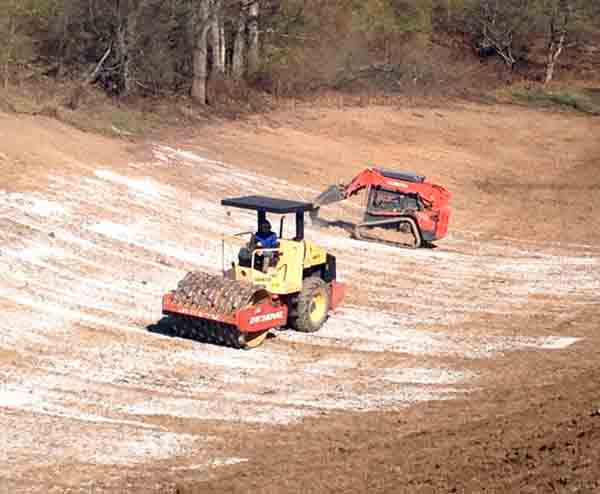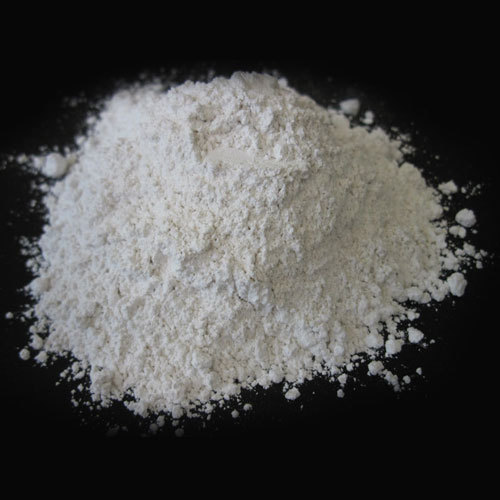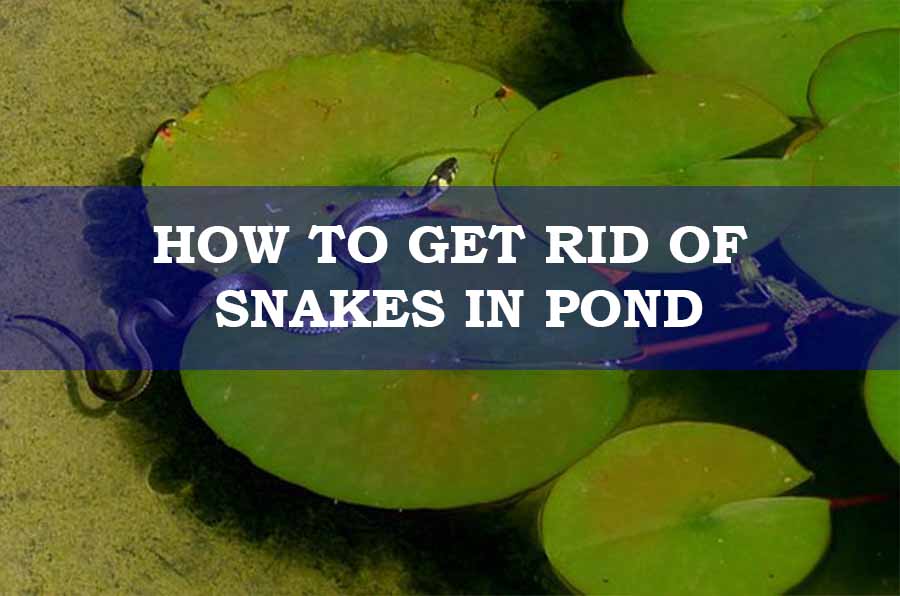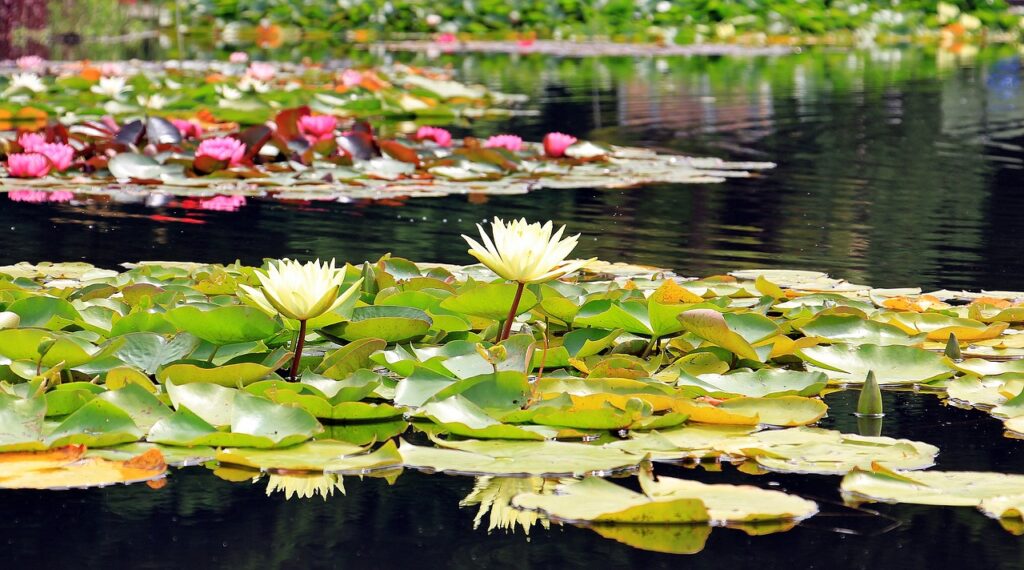Sealing a pond with bentonite is the most effective method to make the pond retain water. Sodium Bentonite clay is used for this purpose. In this article, you will learn how to seal a pond with bentonite by three methods.
The methods of fix a leaking pond with bentonite are as follows-
- Sprinkle Method
- Blanket Method
- Mix Blanket Method
Table of Contents
Method 1: Sprinkle Method
The Sprinkle method is simple to perform. You have to sprinkle the bentonite to the leakage area by a broadcast spreader or by hand. This method is less effective than the other two methods of sealing pond with bentonites. This is because it’s not possible to place the bentonites evenly to the bottom of the pond when you are spreading them from the top of the water.
When to Adopt This Method
- There is no way you can drain the pond.
- Draining the pond isn’t feasible.
- Leaks are isolated from each other.
- The leaks needed to be fixed quickly.
Which Bentonite to Use?
For sprinkle method, you have to use the granular bentonite. Bentonite particles are very fine. If you sprinkle them, they will float on the pond surface and will not reach the bottom of the pond. On the other hand, granular bentonite is large and it will sink to the pond bottom. Therefore, you have to use the granular bentonite for the proper sealing of the leakage.
How Much Bentonite Will You Need?
The application rate for the sprinkling method is higher than the following two methods. For proper sealing of the pond bottom, you have to apply almost 5 pounds of granular bentonite for every square foot.
How to Apply
Step: 1
In sprinkle method, your first task is to clear the pond bottom. Remove any debris such as trash, leaves, rocks, pondweeds, etc.
Step: 2
After that you have removed all the debris and identified the leaks, your final job is to sprinkle the granular bentonites evenly in the leakage areas. The particles will reach the pore and swell to fix the leak.
If you can identify the more porous areas, apply bentonite to these areas first. It can reduce seepage to a great extent so that you may to need to apply it to the whole pond.
Cautions
- Bentonite particles are very fine. When you apply them to the pond, you may inhale some with air. Therefore, use a face mask to prevent them from reaching your lungs.
- Don’t carry out this method if the weather is too hot.
- If there are excess leaks and it requires you to apply a large amount of bentonite, do the job in the course of several days of interval. And not never if possible.
- Using bentonite in the sprinkle method to seal a pond can cause cloudiness in pond water. This is not permanent and the water will be fully clear within several days. As bentonite isn’t toxic, you can use the water for any purpose.
Method 2: Blanket Method
The blanket method is the most effective method of sealing a pond with bentonite. You can adopt this method for both newly excavated and old ponds.
When to Adopt This Method
- The soil of the pond bottom is highly porous and the permeability rate is high.
- Livestock has access to the pond.
Which Bentonite to Use
For the blanket method, you will need fine or powdered form bentonite.
How to Apply
Step: 1
If you have an old pond with water, first drain the water from the pond. Collect all the debris from the pond bottom.
Step: 2
Let the pond dry until the soil reaches the optimum moisture content. The optimum moisture content of the soil is necessary for maximum compaction.
Step: 3
Divide the pond bottom in a number of plots. You can take any area from 100 square feet to 200 square feet.
Step: 4
Remove the topsoil and gather them in a place. If livestock doesn’t have excess to the pond, remove 5 to 6 inches of topsoil. But if the pond is accessible to livestock, remove at least 8 inches of topsoil although 10 inches is recommended.
Step: 5
Find any holes and fix them with five parts of soil and one part of bentonite.
Step: 6
Prepare the bottom surface of the pond by smoothing it with a roller. This will also compact the soil to some extent which will reduce the porosity of the soil and help it to retain water.
Step: 7
The next task is to spread the bentonite clay in the area. Be sure that you spread them evenly and there is no thin layer. This is very important for an effective seal.
Step: 8
Now spread the soil that you have gathered in step 4 over the bentonite layer. Be sure you don’t disturb the bentonite layer while spreading the soil.
Step: 9
The final task is the compact the soil. Use a roller or temping plate for this job.
After you have completed all the tasks, you can wait some days to swell the bentonite clay. Again if you are in a hurry, you can fill the pond with water just after completing these 9 steps.
When you add water in the pond after bentonite treatment, make sure the flow is gentle. Because a turbulent flow can disturb the layer of bentonite and seepage can occur in these places.
Cautions
- Remove all the debris from the pond before you start the job.
- Be sure you take small plots to fo this job.
- Leave no blank space.
- Carefully add the water so that you don’t disturb the bentonite layer.
- Maintain a good depth of soil layer.
- Have good compaction by achieving an optimum moisture content of the soil.

Also Read: Sealing a pond with lime
Method 3: Mix Blanket Method
The mix blanket method is almost similar to the blanket method. The only difference is here a layer of bentonite and soil mix is used instead of a pure bentonite layer.
How to Apply
Step 1:
Strain the pond if it has water and cleans all the debris from the pond bottom.
Step 2:
Let it be dry to reach optimum moisture content.
Step 3:
If you find any hole patch them with 1:5 bentonite and soil mix.
Step 4:
When the soil has reached the optimum moisture content, plow it at a depth of 6 inches if the porosity is less. Again if the porosity is more, you have to plow it up to 12 inches.
Step 5:
Apply the recommended amount of bentonite to the soil. Use a broadcast spreader for this job to get an even spreading of bentonite.
Step 6:
Now mix bentonite and soil altogether by discing and tilting. You can use a rake for this job if the pond is small. But if the pond is large, then you can plow it again to have a good mixing. Have multiple cross-passes when you plow the pond so that you get the maximum mixing and leave no bare spot.
Step: 7
Finally compact the soil and bentonite mix with a roller. You can use a large mechanical roller for this job if the pond is large. Again for a small pond, this job can be done with a small lawn roller.
Cautions
- Maintain good depth if livestock has access tot he pond.
- Leave no bare space.
- Use the recommended amount of bentonite.
- Thoroughly mix soil and bentonite together.
- Gain maximum achievable compaction.
- When you add water, make sure you don’t disturb the bentonite-soil layer.
FAQ’s (Frequently Asked Questions)
How much bentonite is needed to seal a pond?
The amount of bentonite required to seal a pond depends on the porosity of pond soil. Because high seepage of water occurs if the porosity is more. Texas Bentonite recommends you use it in the following amount depending upon the type of soil of your pond –
- Clay Soil: 1.0 to 1.5 lbs per sqft
- Sandy Silt: 20% Clay Min 2.0 to 2.5 lbs per sqft
- Silty Sand: 3.0 to 3.5 lbs per sqft
- Clean Sand: 4.0 to 4.5 lbs per sqft
- Rock Or Gravel: 5.0 to 6.0 lbs per sqft
How much bentonite do I need for a 1-acre pond?
It depends on the soil type of your pond. As you know 43560 Square feet make an acre. For example, if you have clay soil in you will need 4356 lbs of bentonite. But if you have gravel or rock in the pond bottom, then you will need 5 times more of clay soil
Is bentonite harmful to fish?
Bentonite is a natural substance. It is nontoxic to fish. But as the particles are fine if the concentration is high in water it can attach to the fish gills. This can reduce the oxygen absorbing capacity of the gills and fish may die due to the lack of oxygen.
How much does bentonite cost?
According to Statistica, the average price of bentonite is $77 per ton when this content was written. This price is applicable when you buy them directly from the manufacturing factory. But the cost will increase if you buy them in a small amount. The average price of a 50 lb bentonite bag is about $85
What is bentonite waterproofing?
Bentonite is a clay. When it is exposed to water, it absorbs water and expands. In the leaks, it expands by absorbing water and thus fills leaks to make it waterproof.




Hi I am doing the sodium bentonite blanket method for a small swimming pond on my farm in BC. What is the maximum slope I can use for the sides of the pond? Can I do 45% 35%?
Thanks
Simo
N
For the stability of slope, it should not be more than 1:3 or 18 degrees. 30% seems ok, but in that case you should give nice compaction and it amy also require soil stabilization.
I am doing a small dug out pond. How do I seal the sides?
Use the blanket method of bentonite sealing. Maintain the slope 3:1 or 33 degrees. And don’t forget to give good compaction to it.
Can you recommend bentonite manufacturers for direct purchase? I need about 3000 lbs. for mixed blanket application.
I think you can contact Texas Sodium Bentonite for this.
Thank you!! I found super-cheap sodium bentonite sold as “bentonite 325 mesh” by a ceramics store. Can use this product to seal my pond?
I think it will be better to use regular sodium bentonite for the job.
I have a pond that is 4 years old. Starting losing water about 2 years ago. Not sure where the leak is. It does retain water to a certain level. The pond was lined with natural clay. Not sure what caused the seepage. I have a small amount of catfish in there and I do not want to drain and start over. I was going to use the sprinkle method. I just need advice… how much..and sprinkle ?? do I sprinkle on the dry sections of pond as well as the water?
Please help me make this decision.
Thank you
You should examine the areas in the level where the water draining stops to find what caused seepage. Sprinkling on the dry section will not work as there is no water to swell the bentonite clay. Again the sprinkling method will only work for a flat or slightly inclined surface such as pond bottom, not on the edge.
I have a small koi pond approx 1000 gallons with a edpm rubber liner that is leaking water. Could I use this product to seal the bottom of my pond, which is where the leaks are. I do not want to drain all the water out to repair.
You can try the sprinkle method to do so. Make sure to clean the debries from the leakage area.
Is there any way I can use bentonite vertically to line the sides of a pond? I’m planning on building a 6x6ft water garden and that’s too small to have a slope of less than 30 degrees. If I wet the bentonite first and mixed it with soil, placed it on the sides, then covered it with more soil (so the blanket method but vertical) and kept stacking it on top of each other do you think that would work? I plan on having steps so that it’s not a direct 4ft up, each vertical section would only have to go about a foot.
And if it did leak, would the sprinkle method be sufficient to seal it? Thank you
You can use the mix blanket method but i’m not sure the side will sustain over time as the slope is steep. I think for a 6X6 feet water garden using a pond liner will be better.
You can’t use sprinkle method for a steep slope.
How heavy should the lawn roller be to compact the be bentonite? Is 270 lbs/123 kg heavy enough?
If I want to decrease angle of slope, can I add soil to slope and then compact with lawn roller?
THANK YOU SO MUCH!!
The weight doesn’t matter for a roller, what matters is the pressure it can apply. 270 lbs will work if the contact area is small.
You can flatten the slope adding soil. That will be fine. But it will be hard to compact it suing a lawn roller as it is designed to work on a flat surface.
If I’m installing a dock in my pond, should I add the dock first, apply bentonite to pond, and then reinforce around area dock legs with cement? Sorry for all the questions!
Add the dock first.
my pond 40 years old it is filling up with moss and muck it needs cleaning out but it has a liner can i use bentonite to seal after dregging out pond
If you want to reuse the old liner, then you don’t need to use bentonite. But I think the liner is old enough to be damaged. Also if the pond is small, you better use liner for it.
Hi, i just dug a rectangular 15m x 8m x 1.5m pond, I tried filling it up with water but it’s losing water fast. I will be trying sodium bentonite on the pond. I’m worried that after applying sodium bentonite, fish waste will not be decomposed into the pond bed and might contaminate the pond as time goes by. Do I need to fix a external filter in this case?
It depends on the population of fish. If you stock more fish then I recommend you install an external filter. But when the pond matures, the filter will be of less necessity. This is simply because beneficial bacteria will grow in your pond naturally over time and they will decompose the fish waste.
So if you don’t want to install a filter, the I will recommend you start will a small number of fish and then when the pond matures stock the rest.
I have a hole in the side of my pond near the top, that was caused by crayfish. The hole has been there some time and it has ben leaking but not the water level is slightly below the hole. Should I enlarge the hole and fill the hot with Benonite Benonite to stop the leak?
If you want to keep the water level below the hole level, then there is no need to fill the hole with bentonite, otherwise, you can use bentonite if you want.
I have a pound with a slope greater than 30 degrees. What do you suggest?
Hi Paulo.
Thaks for your comment. Use the mix blanket method.
Hi we removed a tree and put in a small pond. We left some of the tree roots for a water feature. We have tried many products but can’t stop the leaks. Any suggestions? My poor husband is going crazy trying to fix it.
Great article – thank you.
I have a pond in central Texas about 100ft across and 12ft deep. The upper 8ft is caliche clay and water seeps out slowly. The lower portion (about 60ft diameter) is good clay and it holds fine. I am considering lining just the upper portion with bentonite while the water is below the clay line. Would this work or do I need to drain the entire pond and bentonite everything? How thick a layer is 1.5 Lbs/sqft ?
It will definitely work Graham. You don’t need to drain the whole pond.
By the way, I visited your website. It’s great.
Thank you – how thick a layer of bentonite would I put down?
Hi, Mostaq;
I have a small concrete pond with a show leak. It is older. Do you think bentonite would adhere to the concrete to stop the leaks? The pond is drained right now.
I don’t think bentonite will be a good option to seal a concrete pond. If there are large crack you should patch with fresh concrete. For micro-crack, you can use a concrete pond sealer. This article can help: Best Pond Sealer And Paint That Are Safe For Fish
Hi,
One of the farms in Qatar has a problem of leakage from the waste ponds (dairy farm), it seems that the HDPE membrane was damaged somewhere and consequently the wastewater leaked from one pond to another, they made a huge balloon for the membrane, and they asked us to replace the HDPE membrane (where they had a balloon) Without touching the first pond where the wastewater leaks:
We want to know if we find a leak through the dike How can we stop it for at least two months until the membrane is replaced?
Pond1 leak (most likely) to pond2 (where the balloon appeared).
We have to repair pond2 first,
Hi, we just dug up a 12×25 pond, 4ft is the deepest area, the soil is clay. Planing on doing the blanket method and I found bentonite 350 mesh is way cheaper than sodium bentonite, can I just use the bentonite 350 mesh for it? If so how much per square ft in my clay dirt?
I have a largish backyard koi pond, approx 2000 gallons. Pond has liner, but there is a leak somewhere just below skimmer level, so not able to maintain level high enough to run system. Large (very large) rocks are on sides and edges, can’t identify leakage area to treat – is there any trick to locate a leak when rocks are too large to move?
If there is a leak the water level will be stagnant at that level. You should look for the leak in that level.
i just built a 4′ by 6′ koi aquarium pond with 1″ thick tamper glass on one side. i have a minute leak in one spot coming from the front glass. i know the leak is coming seeping through the concrete brick where the mortar was between the bricks. i tried the Paris powder with two inches of water so it will adhere to the leak passage. i did fill one end of a 3/4′ PVC so the Paris powder will not mix with water on contact until the powder reached the pond bottom. the powder got hardened stopping two leak areas. there one leak is still one leak. do you think the bentonite powder will do the job since it will penetrate even the slightest crack? so far this water leak got smaller. it may be the Paris powder residue is finally working into the crack. so far the two koi swimming and adapting to the new pond. i’m using the neighbor overhanging palm leaves lay on the pond surface to block off the hot sun on the pond.
Small man made pond 60ft x30 ft from early 90s without liner is now at half the water level. Home to fish and frogs so prefer not to fully drain. We have a trickling water source/wet/muddy area approx 50 yards away at bottom of trail that is unexplainable and out of place. Is that likely related? What are my options at this point with half of the pond edges exposed? Thank you